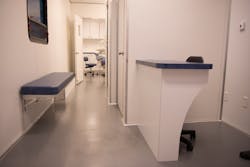The pandemic ravaged the world and changed the way we operate in nearly every facet of our lives. For dentists, especially new dentists, the traditional models for practice changed dramatically, even before the COVID crisis. Out-of-control student loan debt is a major factor driving these changes and preventing many new dentists from following the time-honored track of owning their own practices.
Rising prices on everything from gas to groceries has led to many patients being forced to choose between visiting the dentist or paying for basics. Of course, with rising prices, dentists must pay more for the things required to operate a dental practice. Couple that with the staffing short-age and the resulting increase in salaries, and the situation becomes even more difficult, especially for new graduates. Dental practices need to look for new ideas in the face of these crises.
However, in every crisis there is opportunity! As more patients are reluctant to travel to dental offices, the ability to offer convenience and efficiency affords a competitive advantage to those dental professionals willing to seek a new paradigm. Enter mobile dentistry. Gone are the days when mobile dentistry is a second-class practice modality done in shoddy facilities in compromised conditions that allow only cleanings, extractions, or substandard treatment. Done right, today's mobile clinics are every bit as nice and state-of-the art as traditional brick-and-mortar facilities, and they can be purchased and operated at a fraction of the cost, even before the massive tax advantages are considered.
Mobile facility advantages
Dentists can operate a mobile practice as a stand-alone model, as we have done successfully in our practice, Dental Access Carolina, for more than 20 years, or they can offer mobile dentistry as an extension of their traditional facility. Mobile dentistry affords patients more convenience and access to care, which leads to increased productivity and reduced overhead for the doctor.
Related reading
Mobile dentistry and teledentistry: Are you in or out?
A mobile dental van offers hope for the underprivileged
Mobile offices can be built on a self-powered, RV-type chassis, or on a trailer that must be towed. Each platform has its own advantages and can be built in a variety of sizes and costs. The self-powered units are easier to operate for a novice driver and can be easily moved. A trailer can house a clinic that looks and feels more like a traditional office because it can be larger and placed in a stationary location for longer periods of time. In each type of clinic, all the necessary dental office components are included.
Space is used to ensure maximum efficiency, and nonproductive space is nearly eliminated. This makes the resulting square footage more profitable while sacrificing very little in terms of luxury.The average dental practice in the US produces $732,340 per year with a stagger-ing 72.4% overhead.1 That equates to the dentist needing to produce $530,214 before one dollar of take-home pay is generated. That overhead number is likely to rise in 2022 due to costs going up and the limited ability of dentists to raise their fees sufficiently to fully cover those costs and retain patients at the same time.
The costs and look of mobile dentistry
For dentists who want to expand their traditional facilities or open a new office, the average cost for upfits specific to dentistry is approximately $200 per square foot, plus the cost of the building. The average cost to equip a dental operatory is $45,000. The average dental office produces approximately $180,000 per operatory,2 so an office needs four operatories to reach the average production number. However you do the math, costs are very high and must be spent before the first dollar is collected. To attenuate that problem, mobile dental offices can be used as temporary facilities where patients can be treated and fees collected while the necessary construction is in progress. The same holds true when a mobile facility is used as a temporary office if the practice experiences a disaster such as a flood, fire, or other natural disaster.
So, what does a mobile office look like? For a practice that wants to pursue more complex procedures, the most efficiently designed mobile dental office has two treatment rooms, a sterilization room/lab area, a staff restroom, and a panorex alcove. A small waiting area and office can also be included. An open concept can be created, which allows for more chairs but less privacy. Some hygiene-only, orthodontic, and pediatric practices prefer the open concept but, again, privacy for the patient is limited in this design.
A wheelchair lift or ramp should be considered if required by law or if disabled patients are treated. With a typical two-treatment room design, the complete cost of a mobile clinic can be less than the cost of upfits to a brick-and-mortar facility. Additionally, if adequate parking is available, mobile clinics can be connected or used in tandem, allowing the number of treatment rooms to be increased without compromising mobility of the clinic.
How much can one produce in a mobile clinic? Based on our 20-plus years of experience, production per chair exceeds that of the traditional office production. This is primarily due to the efficiencies of the mobile clinic design and the scheduling. In a traditional office, it’s rare that all treatment rooms are fully used during the day due to many factors, such as no-shows, late arrivals, or cancellations. Those factors are affected by several issues, the most common being transportation.
When the mobile clinic is onsite where patients are already located, transportation issues are eliminated, which results in maximum efficiency and utilization of the productive space in the clinic—the treatment rooms. That, coupled with a reduced need for nonproductive space—waiting rooms in most scenarios—creates a win-win in terms of cost versus production per square foot.The financial advantages of a mobile clinic are magnified when depreciation is considered, along with the lower costs of acquisition.
The average depreciation schedule for a brick-and-mortar facility is 30 years compared to a “normal” five-year schedule for a mobile clinic. However, the real advantage comes when one considers the IRS Section 179 deduction that allows for a first-year write-off of up to $1,080,000 for equipment placed in service in 2022.3 A doctor can write off 100% of income up to $1,080,000 the first year a mobile clinic is in service, with any excess deduction carried over for the full five-year depreciation schedule.
Using the average production of $742,490 with 72.4% overhead, a practice generates income for the doctor before taxes of $204,927. In this example, depending on one’s filing status, the Section 179 deduction could result in an increase in take-home pay of $49,182 to $65,577 during the first year alone. Not small change by anyone’s math! Check with your tax advisor for the exact rules on this deduction, but no matter how you slice it, it’s hard to imagine a scenario where one can get a better tax advantage.
There is much more to mobile dentistry, but by all accounts, it is a practice modality whose time has come that offers a myriad of opportunities. While it may not be right for all situations, it has a definite place in the market, and it is here to stay. Hopefully I have sparked your interest and offered options to those who want to practice a new way in the new normal.
References
1. Dental practice research. American Dental Association. https://www.ada.org/resources/research/health-policy-institute/dental-prac-tice-research2
2. Based on conversation Dr. John Reese had with Patterson Dental rep.3. Section 179. What’s new for 2022? IRS. https://www.irs.gov/publications/p946#
3. Section 179. What's new for 2022? IRS. https://www.irs.gov/publications/p946#
About the Author

John E. Reese III, DMD
John E. Reese III, DMD, graduated from the Medical University of South Carolina in 1988, where he has also been an adjunct professor. He is a fellow in the Pierre Fauchard Academy and the International College of Dentists. In January 2001 he founded Dental Access Carolina (DAC), a mobile dental practice providing comprehensive care to economically disadvantaged children. Dr. Reese builds mobile clinics and offers consulting on practice management and mobile dentistry. To learn more, visit dentalaccess.com.
Updated June 23, 2022


